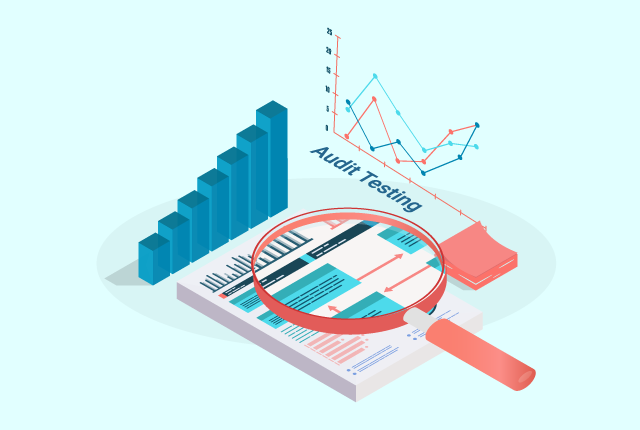Financial Statement Audit: Dive into the Examination Process
The financial statement audit is a comprehensive and rigorous process that provides independent assurance on the accuracy of a company’s financial statements. In this blog post, we will take a deep dive into the financial audit process and its significance for stakeholders.
Understanding the Objective of a Financial Statement Audit:
The primary objective of a financial statement audit is to express an opinion on whether the financial statements present a true and fair view of the company’s financial position and performance. We will explain how auditors assess the overall reasonableness of the financial information.

Planning the Audit Engagement:
The audit process begins with careful planning. We will discuss the importance of understanding the business environment, identifying risks, and designing Financial Statement Audit procedures to obtain sufficient and appropriate audit evidence.
Audit Procedures and Testing:
During the audit, auditors perform various procedures and tests to verify the accuracy and completeness of financial data. We will explore these procedures, such as substantive testing and tests of controls, and their role in gathering evidence to support the auditor’s opinion.
Analyzing Internal Controls:
Internal controls are critical in ensuring the reliability of financial information. We will examine how auditors assess the effectiveness of internal controls and their impact on the audit opinion.
Forming the Audit Opinion:
Based on the results of the audit procedures, the auditor forms an opinion on the financial statements. We will explain the different types of audit opinions and what they signify to stakeholders.
The financial statement audit process is a systematic and meticulous examination that provides valuable assurance to stakeholders about the reliability of a company’s financial statements. By understanding the objective, planning, audit procedures, internal controls, and forming the audit opinion, stakeholders can appreciate the rigor and value of a financial statement Audit in Chatham
.
Financial statement audits are critical processes that provide stakeholders with confidence in a company’s financial reporting accuracy and compliance with relevant accounting standards. In this blog post, we’ll take a comprehensive look at the financial statement audit process, from planning to reporting, to understand how auditors ensure the reliability of financial information.
The financial statement audit process is a systematic and meticulous examination that provides valuable assurance to stakeholders about the reliability of a company’s financial statements. By understanding the objective, planning, audit procedures, internal controls, and forming the audit opinion, stakeholders can appreciate the rigor and value of a financial statement Audit in Chatham .
Financial statement audits are critical processes that provide stakeholders with confidence in a company’s financial reporting accuracy and compliance with relevant accounting standards. In this blog post, we’ll take a comprehensive look at the financial statement audit process, from planning to reporting, to understand how auditors ensure the reliability of financial information.
Planning Stage
a. Understanding the Client’s Business: The audit process begins with auditors gaining a thorough understanding of the client’s industry, operations, and financial reporting history. This knowledge helps in identifying risk areas and tailoring the audit approach.
b. Risk Assessment: Auditors assess the risks associated with the client’s financial statements, including fraud risks and internal control weaknesses. This evaluation guides the audit plan’s focus.
c. Audit Plan Development: Based on the risk assessment, auditors develop an audit plan outlining the scope, objectives, and procedures to be followed during the audit.
Internal Control Evaluation
Auditors evaluate the client’s internal controls, which are the processes and procedures in place to ensure accurate financial reporting. They assess the effectiveness of internal controls in preventing or detecting material misstatements.
Substantive Testing
This phase involves the detailed testing of account balances and transactions to gather evidence about their accuracy and completeness. Substantive testing includes:
a. Testing Transactions: Auditors examine a sample of transactions to verify that they were recorded accurately and are supported by appropriate documentation.
b. Analytical Procedures: Auditors compare financial data, ratios, and trends to expectations, helping identify unusual fluctuations or discrepancies that require further investigation.
c. Confirmations: Auditors may send confirmations to third parties, such as customers or banks, to verify the accuracy of account balances and transactions.
Audit Sampling
Auditors use statistical sampling techniques to select a representative sample of transactions or balances for testing. The results from this sample are extrapolated to draw conclusions about the entire population.

Audit Documentation
Throughout the audit, detailed records are maintained, including working papers that document audit procedures, findings, and conclusions. These records provide a comprehensive trail of the audit process and serve as evidence of compliance with auditing standards.
Reporting Stage
a. Auditor’s Opinion: After completing substantive testing and evaluating the evidence gathered, auditors issue an opinion on the fairness of the financial statements. There are three possible opinions: unqualified (clean), qualified (with exceptions), or adverse (not reliable).
b. Management Letter: Auditors may provide recommendations for improving internal controls, operational efficiency, or compliance with accounting standards in a management letter.
c. Communication with Governance: Auditors communicate their findings and concerns with the client’s board of directors, audit committee, or other relevant governance bodies.
Follow-Up
If significant issues or deficiencies are identified during the audit, auditors may follow up with management to ensure corrective actions are taken. This process helps improve the client’s financial reporting and internal controls.
Conclusion
Financial statement audits are intricate processes that require a systematic and rigorous approach to ensure the accuracy and reliability of financial information. Auditors play a vital role in providing assurance to stakeholders, including investors, lenders, and regulatory bodies, that a company’s financial statements fairly represent its financial position and performance. By following a structured audit process that involves planning, internal control evaluation, substantive testing, and thorough documentation, auditors contribute to the transparency and trustworthiness of financial reporting in the corporate world.
Share This Blog











